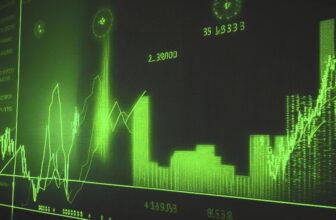
Understand forex trading as we unravel the mystery behind ATR (Average True Range). In this exploration, discover how ATR serves as the compass navigating the seas of volatility, guiding traders with precision.
The average true range (ATR) is a technical analysis indicator used to measure market volatility in forex trading. It provides valuable insights into the average range of price movements over a specified period. By understanding the ATR and its calculation, traders can make informed trading decisions and develop effective strategies.
Key Takeaways:
- The ATR is a technical analysis indicator that measures market volatility in forex trading.
- It provides insights into the average range of price movements over a specified period.
- Traders can use the ATR to gauge the volatility of the market and make informed trading decisions.
- The ATR is calculated using a 14-day simple moving average of the true range indicators.
- Traders can use the ATR in various trading strategies, including setting stop-loss orders and determining position sizing.
What Is ATR in Forex
In forex trading, understanding market volatility is paramount. One key tool that traders employ for this purpose is the Average True Range (ATR). This technical analysis indicator, introduced by J. Welles Wilder Jr., serves as a compass for measuring and navigating the twists and turns of market volatility.
Managing Market Volatility: Decoding Average True Range (ATR)
Understanding ATR Fundamentals
Average True Range (ATR) stands as a key pillar in forex trading. It offers traders a nuanced lens to decipher market volatility. Developed by J. Welles Wilder Jr., ATR essentially computes the average of true ranges over a predetermined period. This period, typically set at 14, can span intraday to monthly intervals. This provides a versatile tool for traders to gauge the market’s turbulence.
Peeling Back the Layers of True Range
True range is a central part of ATR. It is a dynamic indicator from the greatest value among the current high minus the current low. It also comes from the absolute value of the current high minus the previous close. This intricate calculation captures the essence of market movement, incorporating both price gaps and daily fluctuations.
The Mechanics of Volatility: ATR in Action
Interpreting ATR as a Market Barometer
Picture ATR as the market’s own weather report. When ATR values expand, it signifies increased volatility, with each bar experiencing larger price movements. A reversal accompanied by a surge in ATR indicates a robust market move, highlighting the strength behind the price shift. Importantly, ATR remains non-directional, refraining from specifying whether the increased volatility stems from buying or selling pressure.
A Points of Highs and Lows
Conversely, a low ATR value unveils a period of market tranquility, often associated with extended sideways price action. This tranquility implies lower volatility, akin to quiet days in the market. Prolonged low ATR values may suggest a consolidation phase, creating anticipation for a potential continuation move or reversal.
Illustrating ATR with Examples
Example 1: Decoding ATR Values
Consider a forex trader using a 14-day ATR calculation. If, during this period, the highest true range values amount to $1.73, the average volatility for the asset over these 14 days becomes $1.18. This simple yet powerful calculation provides traders with a quantitative measure of the market’s recent volatility.
Example 2: ATR in Trend Identification
Imagine a scenario where ATR values are rising. This indicates a market experiencing heightened volatility, with prices fluctuating more than usual. Traders can leverage this information to identify potential entry and exit points, adapting their strategies to the evolving market conditions.
In essence, decoding ATR involves demystifying the intricate interplay of true ranges and volatility indicators. This understanding empowers traders to navigate the dynamic seas of forex trading with a clearer perspective, allowing them to make informed decisions based on the ever-changing rhythm of the market.
Mastering ATR: A Technical Aspect of Forex Trading
Calculating ATR: A Simplified Formula
Calculating Average True Range (ATR) involves a technical dance that traders perform to gauge market volatility accurately. The formula is straightforward, relying on a series of true range values over a specified number of periods. This simple yet effective method allows traders to quantify the market’s recent volatility, providing a solid foundation for decision-making.
ATR as a Tactical Tool in Trading: Navigating the Waves
Beyond its role as a mere volatility measure, ATR emerges as a tactical tool in the trader’s arsenal. One notable strategy involves the “chandelier exit,” a technique developed by Chuck LeBeau. This approach integrates ATR to determine trailing stops, dynamically adapting to the highest high the stock has reached since entering the trade.
Example: Chandelier Exit in Action
Imagine a scenario where a trader enters a trade and monitors the market’s highest highs. Using the ATR approach, the trader places a trailing stop under the highest high reached since entering the trade. If the ATR is, for instance, $1.18, and the chosen multiple is 1.5, the trailing stop would be $1.77 below the highest high. This method allows traders to capture gains while safeguarding against abrupt market reversals.
In the intricate world of forex trading, mastering the technical tango of ATR is a game-changer. Traders armed with the ability to calculate and strategically deploy ATR can navigate the market’s ever-changing landscape with precision, adapting to volatility and making informed decisions in the pursuit of trading success.
ATR’s Versatility Explained: A Supplemental Tool Beyond Forex Trading
ATR Beyond Forex: Origins and Adaptations
Originally designed for commodities by J. Welles Wilder Jr., the Average True Range (ATR) has transcended its roots and found a versatile home beyond the forex market. Its simplicity and effectiveness in measuring volatility have made it a valuable companion for traders navigating various financial landscapes, including stocks and indices.
Example: ATR in Stock Trading
Consider a stock trader using ATR to assess market volatility. If the ATR value is high, indicating significant price fluctuation, the trader might adjust their strategy to capitalise on short-term price movements. On the other hand, a low ATR value signals quieter market days, prompting the trader to anticipate potential consolidation or plan for longer-term positions.
Position Sizing in Derivatives: ATR’s Practical Application
ATR’s adaptability extends to derivatives markets, where it serves a crucial role in position sizing. Traders can use the ATR approach to align position sizes with their risk tolerance and the underlying market’s volatility. For instance, a more volatile market may prompt a trader to reduce their position size to account for increased risk, while a calmer market allows for larger positions.
Example: ATR-Informed Position Sizing
Imagine a trader entering the derivatives market with a risk tolerance of $1,000 and an ATR value of $0.50. Using a multiple of, say, 2x ATR, the trader adjusts their position size accordingly. If the ATR value is $0.50, the trader calculates the potential price movement as $1.00. This informs their decision to size their position, ensuring it aligns with both their risk tolerance and the market’s volatility.
Limitations and Nuances in ATR Usage
While ATR proves valuable in various financial arenas, it’s essential to acknowledge its limitations. ATR solely measures volatility, not price direction. Traders should interpret ATR readings in conjunction with other indicators to gain a comprehensive understanding of market conditions.
In essence, ATR emerges as a versatile companion beyond forex, offering traders valuable insights into market volatility and aiding in strategic decision-making. Whether assessing stock movements or navigating derivatives markets, the adaptability of ATR continues to make it a reliable and widely embraced tool in the trader’s toolkit.
ATR Calculation in Forex
In forex trading, the calculation of the Average True Range (ATR) involves determining the true range (TR) for a security. Calculation of the true range makes it the greatest value among the current high minus the current low, the absolute value of the current high minus the previous close, or the absolute value of the current low minus the previous close.
Once determining the true range, calculating the ATR is possible. The formula for calculating the ATR depends on whether there is a previous ATR value available or not.
If there is a previous ATR, the formula is ATR (n-1) + TRn / n, where n is the number of periods.
If there is no previous ATR, the formula is the sum of TRi / n, where TRi is the true range for each period and n is the number of periods.
The ATR calculation is essential for traders as it helps them understand the volatility of the forex market and make informed trading decisions. By knowing the ATR, traders can assess the average range of price swings for an investment over a specified period, allowing them to adjust their trading strategies accordingly.
How to Use ATR in Forex Trading
ATR in forex trading informs various trading strategies. One common way to use ATR is to set stop-loss orders. By placing a stop-loss order at a certain multiple of the ATR away from the entry price, traders can protect their positions from excessive losses.
The ATR can also be used to determine position sizing. By considering the ATR and their risk tolerance, traders can determine how much to invest in a particular trade.
Additionally, the ATR can be used in combination with other technical indicators to identify potential entry or exit points. Traders can develop their own strategies based on their understanding of the ATR and its implications for the forex market.
Key Points:
- Use ATR to set stop-loss orders and protect positions.
- Determine position sizing by considering the ATR and risk tolerance.
- Combine ATR with other indicators to identify entry or exit points.
Example:
“I use the ATR in my forex trading to determine the appropriate stop-loss level for each trade. By setting the stop-loss order at 2 times the ATR, I can limit my potential losses while allowing for some price fluctuations. Additionally, I consider the ATR when deciding how much capital to allocate to each trade. A higher ATR may indicate a more volatile market, so I adjust my position size accordingly. Finally, I often look for opportunities where the ATR is expanding, as it may signify a potential trend change or opportunity for profit.”- John Smith, Experienced Forex Trader
| Strategy | Description |
|---|---|
| Stop-Loss Placement | Set stop-loss orders at a multiple of the ATR away from the entry price to limit losses. |
| Position Sizing | Consider the ATR and risk tolerance to determine the appropriate investment amount for each trade. |
| Entry and Exit Points | Combine the ATR with other technical indicators to identify potential entry or exit points in the forex market. |
ATR Trading Strategy
A popular ATR trading strategy involves using the indicator to identify periods of high and low volatility. When the ATR value is high, it suggests that the market is experiencing significant price fluctuations, indicating a potential trend change. Traders can consider this as an opportunity to enter or exit trades. On the other hand, when the ATR value is low, it suggests that the market is in a period of consolidation or low volatility. Traders can use this information to adjust their trading strategies accordingly, such as implementing range-bound or mean-reverting strategies. The ATR can also be used in conjunction with other technical indicators to confirm trading signals and improve overall trading performance.
Conclusion
The average true range (ATR) plays a crucial role in forex trading, allowing traders to analyse market volatility and make well-informed decisions. With a deep understanding of ATR and its calculation, traders can determine the average range of price swings over a specific time frame. This knowledge empowers traders to set appropriate stop-loss orders, accurately determine position sizing, and identify potential entry or exit points.
The ATR serves as a foundation for various trading strategies and can be used in combination with other technical indicators to enhance overall trading performance. Incorporating the ATR into your forex trading approach can provide valuable insights into market dynamics and help refine your trading strategies.
By employing the ATR in forex trading, you can conduct comprehensive volatility analysis and gain a deeper understanding of the market’s movements. This knowledge enables you to fine-tune your strategies based on current market conditions, improving your chances of success in the forex market.
FAQ
The average true range (ATR) is a technical analysis indicator used to measure market volatility in forex trading. It measures the range of an asset’s price movement over a specified period, providing insights into the volatility of the market.
The ATR is calculated by determining the true range (TR) for a security. The true range is the greatest of three values: the current high minus the current low, the absolute value of the current high minus the previous close, or the absolute value of the current low minus the previous close. Once the true range is determined, it can be used to calculate the ATR using specific formulas depending on whether there is a previous ATR value available.
ATR can be used in forex trading in various ways. One common use is to set stop-loss orders by placing them at a certain multiple of the ATR away from the entry price to protect positions from excessive losses. ATR can also help determine position sizing by considering the ATR and risk tolerance. Additionally, ATR can be used in combination with other technical indicators to identify potential entry or exit points and develop trading strategies.
An ATR trading strategy involves using the ATR indicator to identify periods of high and low volatility in the market. When the ATR value is high, it suggests significant price fluctuations and potential trend changes. Traders can consider this as an opportunity to enter or exit trades. Conversely, when the ATR value is low, it indicates periods of consolidation or low volatility, which can be used to adjust trading strategies accordingly.
By incorporating ATR into forex trading approaches, traders can gain valuable insights into market volatility and make informed trading decisions. ATR can help traders set appropriate stop-loss orders, determine position sizing, and identify potential entry or exit points. It can also be used in conjunction with other technical indicators to confirm trading signals and enhance overall trading performance.
















